Water and Wastewater Engineering
Подождите немного. Документ загружается.


17-30 WATER AND WASTEWATER ENGINEERING
Vents. The vents are to prevent the tank from becoming pressurized. GLUMRB (2003) speci-
fies that the vent shall open downward, exclude surface and rainwater, birds and animals, insects,
and dust. A twenty-four mesh noncorrodible screen is required.
Water Quality
Studies in the 1990s (Clark et al., 1993; Kirmeyer et al., 1999) found that long residence times in
storage tanks resulted in decay of disinfectant residuals to levels that were extremely low to non-
existent. In addition, it has been recognized that longer detention times in storage tanks normally
leads to increases
in the formation of disinfection by-products.
Through physical scale models, actual tank tests and computational fluid dynamics, Grayman
et al. (2004) developed the following design and operating criteria to improve mixing and reduce
water quality deterioration:
• The storage tank shou
ld be designed to encourage good mixing rather than plug flow.
• Baffles should not be used.
• M i xing should be enhanced. This can be accomplished by utilizing the jet flow as water
enters the tank.
• For a tank operating on a fill-and-draw mode, mixing occurs primarily during the fill cycle.
Therefore, the
mixing time must be less than the fill time for the tank.
• Although the inlet configuration is secondary compared with the previous factors,
the arrangements shown in Figure 17-13 have a greater potential for causing poor mixing.
• Long detention times lead to decay of the disinfectant residual. Estimates of the d
etention
time and the disinfectant decay rate can be used to establish an acceptable detention time.
For jet flow to accomplish mixing, it must be turbulent. For circular jets, the Reynolds num-
ber remains constant throughout the jet structure and is equal to that of the flow exiting the riser
into the tank.
Fully turbulent jets have Reynolds numbers greater than 3,000. Thus, the design
must incorporate a riser pipe that achieves this Reynolds number.
Mixing time may be estimated using the following equation (Grayman et al., 2004):
t
M
mixing
/
/
10 2
23
12
.
()
()
⎡
⎣
⎢
⎤
⎦
⎥
V
(17-8)
where t
mixing
mixing time, s
volume
V
of water in tank at start of fill, m
3
M momentum ( u )( Q ), m
4
/ s
2
u inflow velocity, m/s
Q flow rate, m
3
/ s
With the requirement that, for good mixing, the fill time must exceed the mixing time, Equation 17-8
may be rewritten in terms of the required change in water volume during the fill cycle as a fraction
of the volume at the start of the fill period:
D
.
d903
13
.
/
()V
V
V
(17-9)
where d inlet diameter, m
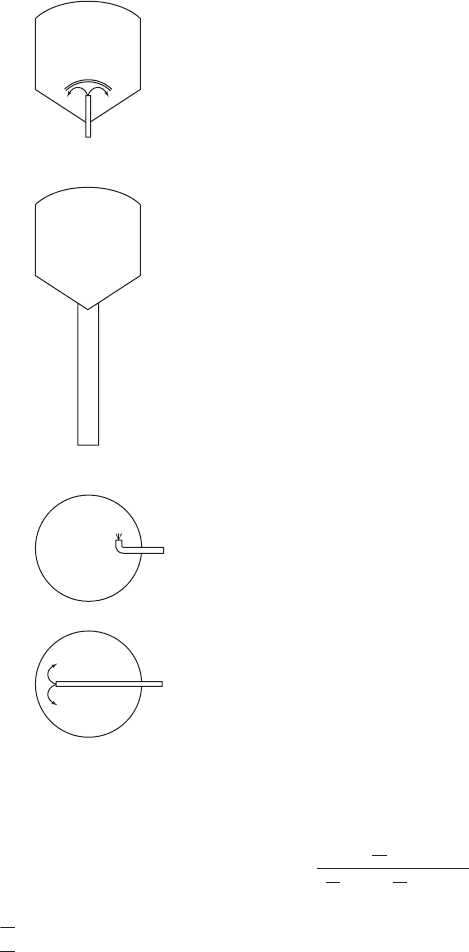
STORAGE AND DISTRIBUTION SYSTEMS 17-31
The theoretical average residence time in the tank is
t
residence
max
V
max
min
)(N)
(
V
V
(17-10)
where
max
maximum
V
daily volume, m
3
min
average
V
minimum daily volume, m
3
N number of fill and draw cycles per day
Hints from the Field
Cellular Antennas. In many loc ations, Federal Aviation Administration (FAA) and local zon-
ing restrictions have limited the ability of cellular companies to build towers. Because of these
restrictions, elevated water storage tanks have become prime sites for installation of antennas.
Side
view
Defectors—do not allow
jet to develop completely,
which may result in
incomplete mixing or lengthy
mixing times
Large-diameter inlets—may
lead to low inlet velocities
and low momentum, which
increases mixing time
Tangential inlet—can lead
to swirling flow, which may
re
sult in dead spot in
center of tank
Inlet directed at wall—does
not allow jet to develop
completely, which may
result in incomplete mixing
or lengthy mixing times
Side
view
Top
view
Top
view
Inlet
Inlet
Inlet
Inlet
FIGURE 17-13
E xample inlet configurations that may lead to mix-
ing problems.
17-32 WATER AND WASTEWATER ENGINEERING
The money from leasing sites on the water tower has become a welcome s ource of revenue.
While the revenue is certainly worth considering, care mu st be taken to avoid the adverse
effects of these installations. Some installations have resulted in structural damage, c oating and
corrosion d a
mage, restriction to access ladders, and contamination through improperly sealed
penetrations. The following recommendations are provided in considering the installation of
antennas (Dixon, 2008):
• The cellular company should provide drawings of its installation. These should include site
u
tilities, ground structures, cable routing, and antenna mounting structures.
• A qualified engineering firm with experience with both storage tanks and antenna installa-
tion should review the plans.
• Structural analysis should be performed to ensure that the tank can support the antennas.
• Inspection of the c
ompleted installation should be performed by a qualified engineer.
17-6 PUMP SELECTION
The fundamentals of pump selection were addressed in Chapter 3. This discussion is limited to
the type of pump, piping arrangements, parallel and series operation, a summary of the steps in
pump selection, and a typical operational procedure.
Type of Pump
P umps used to supply the distribution system are called high-service pumps. High-service
pumps are selected with the objective of providing a high enough pressure to make water flow
at a high rate through service connections at various elevations throughout the distribution sys-
tem. The place where the high-servic
e pumps are located is called a pump station. The location
and configuration of the pump station governs the type of pump construction. If the intake
structure is located below the pump station, for example, in a clear well below the plant, the
common choice is a vertical turbine pu mp. This type of pump was desc
ribed in Chapter 3. In
many cases, the pump station is located downstream of a reservoir where the water level is at an
elevation above the pump station. In these cases, a horizontal centrifugal pump is a more logi-
cal selection. Horizontal centrifugal pumps of split case design ( Figure 17-14 ) are commonly
used
because the rotating element can be removed without disturbing the s uction and discharge
piping.
Variable Speed Pumps. As noted in Chapter 3, variable speed drives, especially the adjust-
able frequency drive (commonly referred to as a variable frequency drive or just VFD ), have be-
come common. The VFD adds both flex
ibility in operation and a potential for savings in energy
costs.
Piping Arrangements. A typical piping system for a high-service pump is shown in Figure 17-15
on page 17-34. Table 17-10 on page 17-35 identifies the elements along with typical K values for
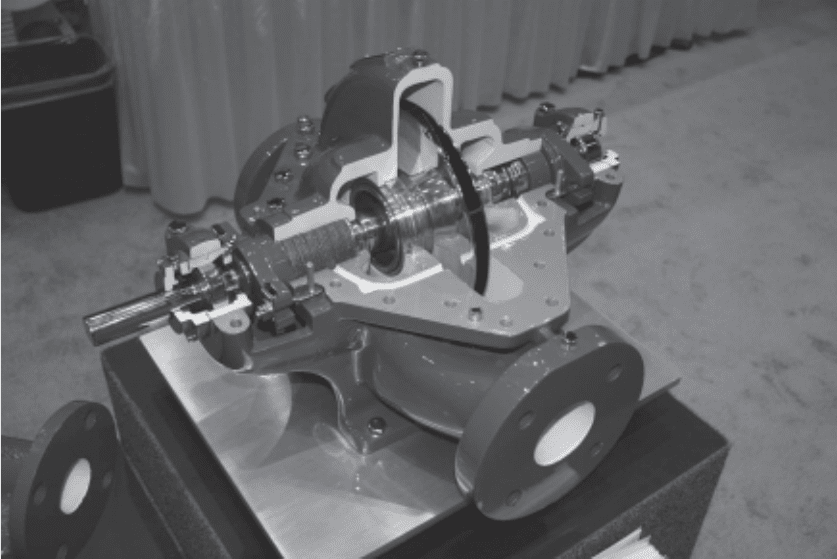
STORAGE AND DISTRIBUTION SYSTEMS 17-33
FIGURE 17-14
Horizontal pump with axially split casing.
( Source: Mackenzie L. Davis.)
calculating minor losses. In order to minimize headloss and turbulence, long radius bends in both the
suction and discharge piping are recommended. Either resilient wedge gate valves or butterfly valves
that meet American Water Works Association specifications are recommended for use as is
olation
valves on both the suction and discharge piping. Additionally, a check valve should be provided on
the discharge pipe to prevent backflow through the pump when the pump is shut down or if there is
a power failure. Although many types of check valves have been used satisfactorily, cone valves are
recommended
because the regulated opening and closing times have proven effective in minimizing
surges (Honeycutt and Clopton, 1976). Cone valves are the “Cadillac” of valves. Other valves can be
designed to minimize surge.
Parallel and Series Operation
Parallel Operation. The use of multiple pum ps in parallel is common practice. Each pump’s
discharge is connected to a common manifold as shown in Figure 17-16 on page 17-35. The
principle on which the design is bas ed is that the total station discharge is determined by add-
ing the individu
al pump discharges at a particular head with the largest pump out of service.
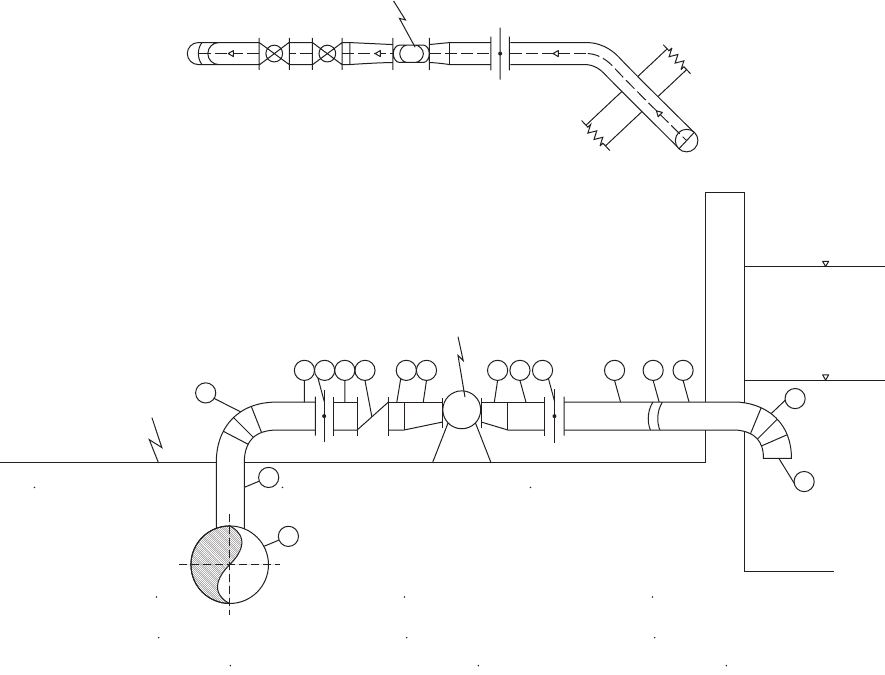
17-34 WATER AND WASTEWATER ENGINEERING
High water
level
Floor
Pump
Low water
level
15
14
16
17
13 12 11 10 9 8 7 5 4 3
2
1
Profile view
Plan view
Forebay
Horizontal split
case pump
6
FIGURE 17-15
High-service pump piping system. See Table 17-10 for key to numbered components.
Because the system head curve rises with increasing flow, the simultaneous operation of two
identical pumps in parallel will not produce a discharge equ al to twice the capacity of one
pump ( Figure 17-17 on page 17-36).
Series Operation. For two identical pumps placed in series operation, the heads are added ,
but the flow rate is not in
creased. This arrangement is not common for a given pumping station.
However, pumps placed in the distribution system to increase pressure ( booster stations ) are, in
effect, pumps operating in series.
If more head is required for a given flow rate at a single pumping station, either multistage
centrifugal pumps or vertical turbine pu
mps are used.
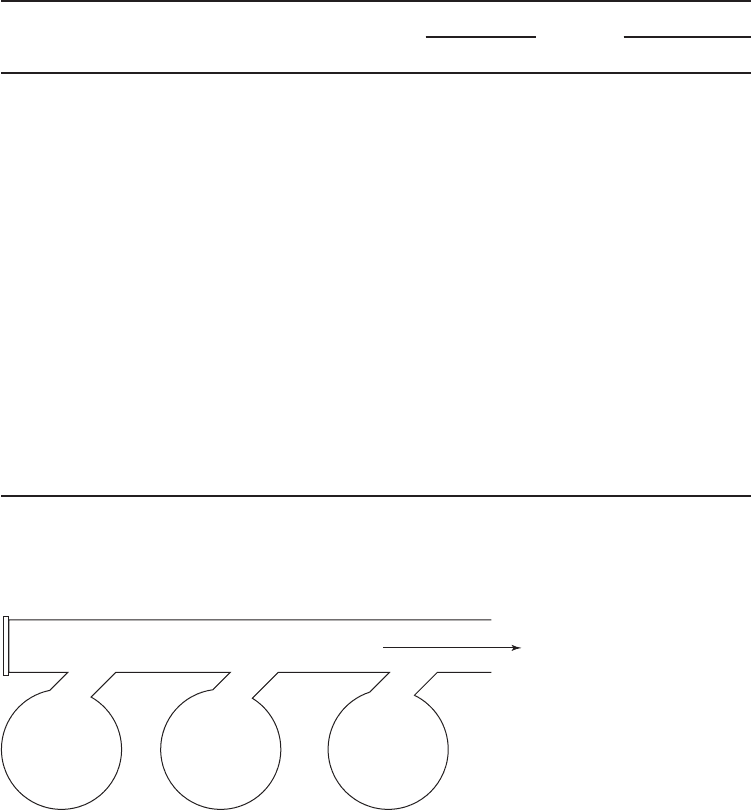
STORAGE AND DISTRIBUTION SYSTEMS 17-35
To system
Pump 3Pump 2Pump 1
FIGURE 17-16
P ump manifold.
Summary of Pump Selection
The following steps summarize the pump selection process:
1 . Plot the system head curves.
2. Modify the manufacturer’s head-discharge curve by subtracting the minor losses in the
pump suction and discharge piping.
TABLE 17-10
Typical minor loss factors ( K ) and Hazen-Williams friction factors (C) for high-service pumping
system
a
Typical K values. Different publications present other values.
b
Reasonable value for mortar-lined steel pipe. Value can range from 130 to 145.
Source: Bosserman, 2000.
Item in
Figure 17-15 Description
Pipe size Friction factor
mm m
K
a
C
b
1 Entrance (ordinary) 300 0.30 1.0
290 elbow 300 0.300.30
3 4.5 m of straight pipe 300 0.30 140
4 30 elbow 300 0.30 0.20
5 2 m of straight pipe 300 0.30 140
6Butterfly valve 300 0.30 0.46
7 1.2 m of straight pipe 300 0.30 140
8 300 mm 200 mm reducer 200 0.20 0.25
9150 mm 250 mm increaser 25
0 0.25 0.25
10 1 m of straight pipe 250 0.25 140
11 Pump check valve 250 0.25 0.80
12 1 m of straight pipe 250 0.25 140
13 Butterfly valve 250 0.25 0.46
14 0.60 m of straight pipe 250 0.25 140
15 90 elbow 250 0.25 0.30
16 1.5 m of straight pipe 250 0.25 140
17 Tee connection 250 0.25 0.50
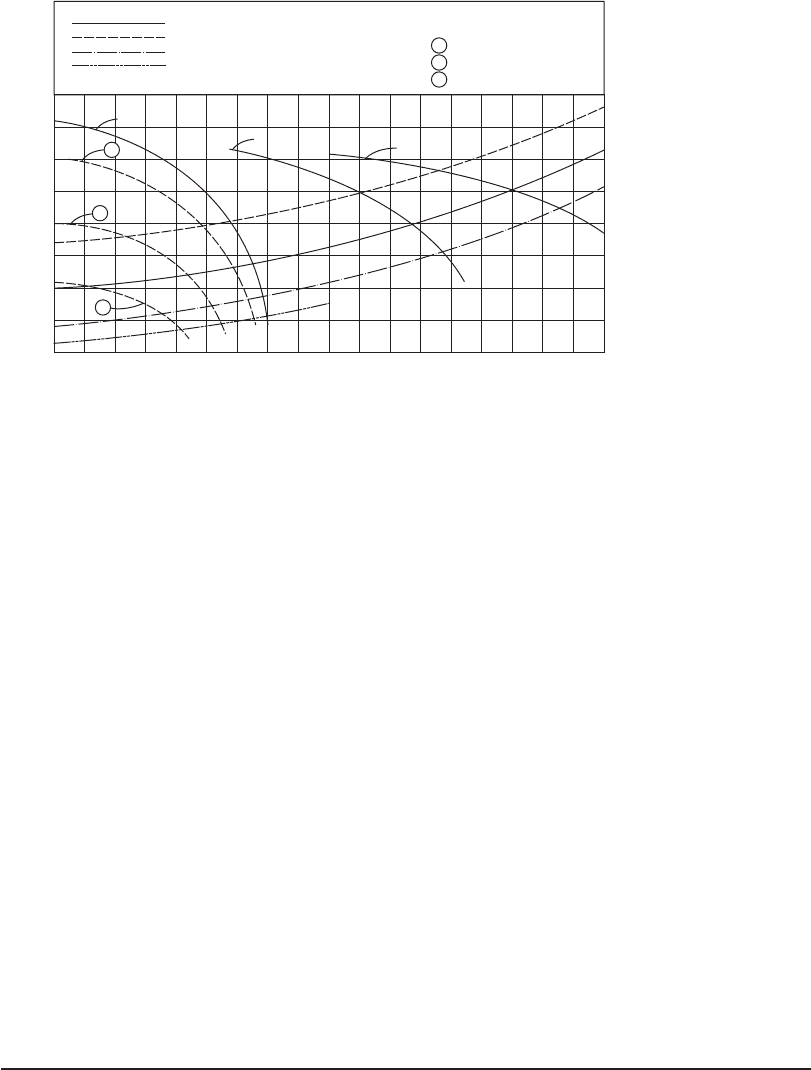
17-36 WATER AND WASTEWATER ENGINEERING
3. Select a pump so that the initial operating point occurs to the right of the BEP.*
4. In multiple pump operations, check the operating point with each combination of pumps
that may operate together.
5. Check that the NPSH
A
* e xceeds the NPSH
R
* for all hydraulic considerations including
run-out.
Typical Operating Procedure
A typical operating procedure for a pumping station with two variable speed (VFD) pumps and
one or more constant speed pumps is as follows:
1 . If the demand flow rate is less that the capacity of one VFD pump, operate one pump.
2. If the demand flow rate is between one and two times the capacity of a single u
nit, oper-
ate both VFD pumps in lieu of operating one unit at full speed and one unit at a speed
less than that required to produce the minimum allowable flow to stay within the pre-
ferred operating range (POR).*
3. If the demand flow rate is more than two times the design capacity of a single unit, oper-
ate two VFD pumps and as many c
onstant speed pumps as required to ensure operation
of all pumps at speeds that will produce flows exceeding the lower bound of the POR.
17-7 NETWORK ANALYSIS
In all but the smallest systems, the pipe network includes loops. That is, the pipe system forms
a grid connected at multiple points. The number of dead ends is minimized in order to provide
*See Chapter 3 for definitions and discussion of these terms.
Design curve @ lake level elev. 128.9 m
Variable speed
application
Pump @ 95% full speed
Pump @ 85% full speed
Pump @ 75% full speed
Curve @ lake elev. 124.7 m
Curve @ lake normal elev. 132.6 m
Lake @ max. flood elev. 134.4 m
0
12
36
1-unit
2-units
3-units
33
30
27
24
21
18
15
50 100 150 200
Pump discharge, m
3
/min
Total head, m
250 300 350
400 450
1
2
3
1
2
3
FIGURE 17-17
S ystem head curve for raw-water pump station.
STORAGE AND DISTRIBUTION SYSTEMS 17-37
increased reliability of service and to reduce headloss. Reliability of service is increased with
loops because interruption of service by a break in the main may be readily circumvented by the
water taking an alternate route to downstream users.
The classical pipe-network flow problem asks what flows
and pressures are in a network of
pipes subject to a known set of inflows and outflows. Two sets of equations are needed to solve
this problem. The first set requires conservation of flow to be satisfied at each pipe junction. The
second specifies a nonlinear relationship between flow and headloss at each pipe. The Hazen-
Williams equation is an exam
ple of this relationship. When the network contains loops, as is the
case in most instances, these equations form a coupled set of nonlinear equations. These can be
solved only by using iterative methods. For all but the simplest cases, a computer is used for the
solution (Ro
ssman, 2000).
At a minimum, preliminary selection of each of the elements of the design discussed to this
point in the chapter must be resolved before the computer program can be used. Once the model
is set up, the selected parameters may be adjusted to improve the mo
del solution.
An example computer program that serves as a basis for the following discussion is EPA-
NET2. EPANET2 is a public domain water distribution modeling package developed by the
U.S. Environmental Protection Agency. The program can be downloaded from http://www.epa.
gov/NRMRL/wswrd/dw/epanet.html .
Network Representation
The vocabulary used in representing the network is summarized as follows:
• Network. The distribution system is represented by a collection of links connected together
at their end points, which are called nodes.
• Links. Pipes, pumps, and control valves are represented by links.
• Junct
ions. These are nodes where pipes connect and water consumption occurs.
• Reservoirs. These represent fixed head boundaries.
• Tanks. These are variable volume storage facilities.
In addition, some informational objects are also used to represent the distribution system.
These in
clude:
• Time patterns to model diurnal water demand.
• Head-discharge curves for pumps.
• Operational controls that change link status depending on tank levels, nodal pressures, and
time.
• Hydraulic analysis options that include the type of headloss equation, unit
s, viscosity, and
specific gravity.
• Water quality options, including compounds, and reaction rate coefficients
• Time parameters, including the duration of the simulation, time steps, and time interval for
output results.
17-38 WATER AND WASTEWATER ENGINEERING
Skeletonization
The process of representing only selected pipes in the model is called skeletonization. This pro-
cess is begun by deciding on the smallest diameter of pipe to include in the model. The advantages
of a skeletonized network are reduced data handling and easier comprehension of the output. The
disadvantages inclu de the need to use engineering judgement in which pipes to include and the
difficulty in aggregating demand from individual users.
A highly skeletonized model may be appropriate for capital improvement planning or pump
scheduling studies. It would not be appropriate for water qualit
y modeling or for fire flow
analysis.
17-8 SANITARY PROTECTION
A n umber of features in the design and installation of the storage and distribution system are
required to protect the water from contamination. Some of these have already been discussed, for
example, screens on openings to storage tanks. They will not be repeated here.
Sanitary Protection of Storage
Location. GLUMRB (2003) specifies the following in siting storage tanks:
• The bottom of ground level reservoirs and standpipes should be placed at the normal ground
surface, and shall be above the 100-year flood or the highest flood of record.
• If the bottom elevation of a storage reservoir must be below normal ground surface, it must
be place
d above the groundwater table. At least 50 percent of the water depth should be
above grade. Sewers, drains, standing water, and similar sources of possible contamination
must be kept at least 15 m from the reservoir. Gravity sewers constructed of water main
quality pipe, pressure tested in place without leakage, m
ay be used at distances greater than
6 m, but less than 15m.
• The top of a partially buried storage structure mus t be not less than 0.60 m above normal
ground surface.
In Michigan, placing any portion of the tank below grade is discouraged.
Disinfection. Finis hed water storage structures
must be disinfected in accordance with
AWWA Standard C652 using Methods 1 or 2. Method 3 is not recommended. In Method 1
a liquid chlorine or sodium hypochlorite solution is fed such that the chlorine concentration
after six hours is 10 mg/L if the solution is
fed uniformly. If it is mixed into the tank, the time
period is 24 hours. In Method 2, the tank is sprayed or brushed with a solution of 200 mg/L
available chlorine. Bacteriological testing after disinfection is used to confirm that disinfection
is complete.
The air space in the tank will have a substantial conc
entration of chlorine gas during treat-
ment. Workers should wear appropriate breathing apparatus and protective clothing including eye
protection to avoid chlorine poisoning and burns. A self-contained breathing apparatus (SCBA)
should be used.
STORAGE AND DISTRIBUTION SYSTEMS 17-39
Sanitary Protection of Water Mains
Location. GLUMRB (2003) specifies that water mains shall be laid at least 3 m horizontally
from any existing or proposed gravity sewer, septic tank, or subsoil treatment system. Water
mains crossing sewers shall be laid to provide a minimum vertical distance of 0.45 m between
the outside of the water
main and the outside of the sewer. It is preferable that the water main be
located above the sewer. At crossings, one full length of water pipe shall be located so both joints
will be as far from the sewer as possible.
For above water crossings, the pipe must be protected from damage and freezing. Typically,
the pipe is hung from a bridge. In extremely cold
climates, this practice is problematic. If the
water crossing is to be made under water, a minimum cover of 0.60 m above the lowest dredged
bottom must be provided. In addition, the pipe must have flexible, restrained, or welded watertight
joints. Valves are to be placed at both ends to isolate the section of pipe. Some provision m
ust be
made to allow determination of potential leakage as well as sampling for water quality analysis.
Disinfection. Finished water mains must be disinfected in accordance with AWWA Standard
C651. The three methods are summarized here (Walski, 2000a).
• Tablet method. This method can be used if the pipes have been kept clean. Some manu
-
facturers are offering to ship the pipe with plugs to keep out dirt, debris, and animals. The
method involves placing hypochlorite granules or tablets in the pipes during installation at
intervals no greater than 150 m. The number of 5 g tablets per length of pipe can be esti-
mated using the following equation:
NLD
()()()64 10
62
.
(17-11)
where N number of 5 g tablets
L length of pipe, m
D diameter of pipe, mm
U sing this method the average concentration of chlorine during the test should be about
25 mg/L. The water must fill the main slowly. A velocity of less than 0.3 m/s is recom-
mende
d. If the water temperature is higher than 5 C, the water must be kept in the main for
at least 24 hours. If the temperature is less than 5 C, the water must be kept in the pipe for
48 hours. This method is appropriate for small mains.
• Continuous feed method. The mains must be flushed at a velocity greater than 0.76 m/s to
remove sediment and air pockets
. Chlorine is fed at a rate that maintains a concentration of
25 mg/L for 24 hours. At the end of 24 hours, the free chlorine residual must be greater than
10 mg/L.
• Slug method. This method consists of placing hypochlorite tablets as in the first method
and then flushing the main as in the second method. Then a slug of 100 m
g/L chlorinated
water is placed in the main for at least three hours. The concentration must not drop below
50 mg/L. This method is appropriate for large mains.
In each of these methods, highly chlorinated water must be disposed of in an environmentally
responsible manner. This may require treatment with a reducing chem
ical such as sodium sulfite.
